350 Search Results for aided language input
June 18, 2012
by Robin Parker -
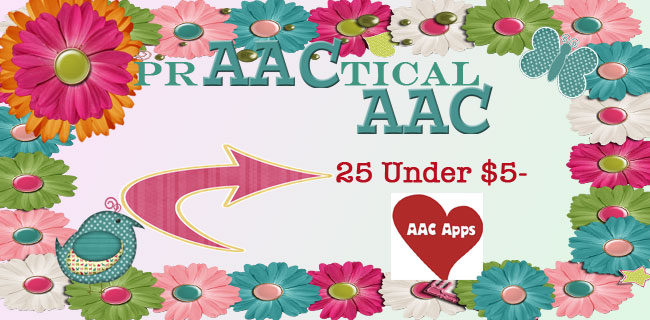
We are now up to 72 Free or Lite version of AAC apps. There is another emerging price point category of apps that are not quite free but fairly close. We were so happy to find 25 apps under $5.oo. These are all regular versions. All the same teaching and preparation is needed when choosing AAC apps, no shortcuts here, but deciding if you need an app for ‘small talk’ or telling stories or labeling may help make it easier to decide which AAC apps to try. The RelAAAC rubric may help with these decisions after a feature match process is done. After selecting the AAC app, then comes the fun part. You can be creative by setting up fun opportunities to communicate. Communication temptations can be set up for requesting (putting favorite toys in a closed screw top jar) and commenting (wearing really big fun hats/glasses). And don’t forget... [Read More...]
May 30, 2012
by Carole Zangari -
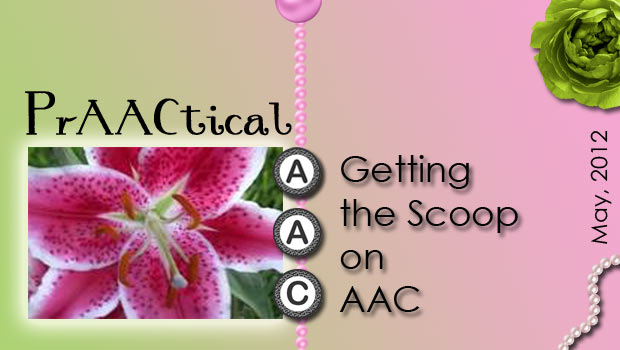
When I first heard about curation being the next big thing on the internet, I had a hard time seeing how I would have time to get involved. Less than a year later, I can’t conceive of being on the internet without my curation tools. Every day, something comes up that I want to store on a curation site. And it’s almost every day that I send someone to those places for a specific tool, video, article, etc. – In addition to Pinterest, which we blogged about earlier, we are frequent users of Scoop.It and LiveBinders. Each one has its unique properties and so, they are each useful for different things. – Scoop.It is a pictorial magazine where you can collect and share websites related to topics of interest. Unlike Pinterest, with Scoop.It, you can add things that do not have a sizable image. Anyone can view Scoop.Its, but if... [Read More...]
May 21, 2012
by Carole Zangari -
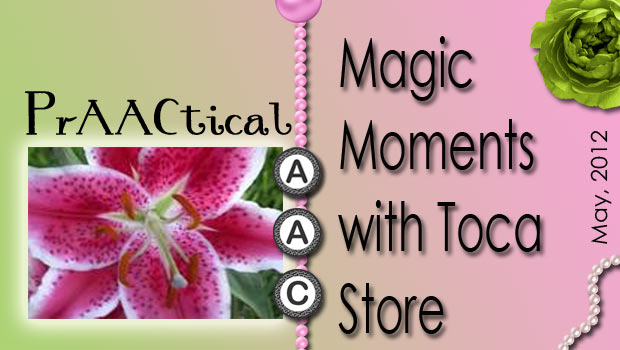
It’s no coincidence that some of our favorite apps to use with AAC kids don’t rely on good receptive language in order to be successful and have fun. Count us among the fans of Toca Boca for their creative play-based apps with great graphics and lots of repetition with variety. In this post, we share some Magic Moments for using Toca Store as a communication-building experience.– 1. Core Word Practice: Lots of opportunities for practice with familiar nouns (e.g., banana, doll), common verbs (e.g., get, see, want) and modifiers (colors, some, little). 2. Negation: This is another fun app to use when teaching a child to use language appropriate for negation, protests, and rejection. We like teaching that under low stress conditions like this at first to build their skills. Once they get the hang of it, then we help them use it under more natural conditions. That way we can... [Read More...]
May 15, 2012
by Carole Zangari -
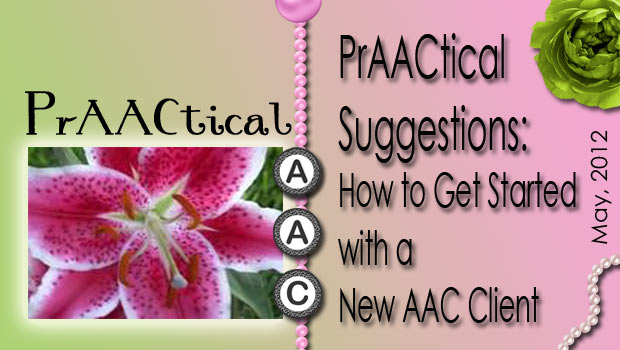
– This is the first week of a new semester for us, and that means we get the pleasure of introducing a new crop of student SLPs to clients with AAC needs. We’ve been busy looking at lesson plans, discussing goals and objectives, listening to ideas for therapy activities, and helping to develop plans for data collection. With those recent conversations buzzing in our ears, here are some thoughts about getting AAC therapy sessions off to a good start. – 1. Connect with the client and family before the first session. Take some time to plan out questions that will help you get to know their expectations, family culture, and daily routine. 2. Know the history. Go beyond the diagnosis and device. Take time to research what’s been done before, how that worked out, and, if you can, how that was perceived. Knowing where the client has been on his/her... [Read More...]
May 13, 2012
by Robin Parker -
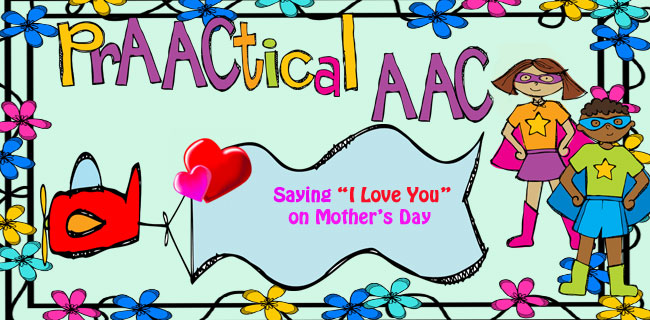
Saying “I Love You” is very important to most moms (and dads), especially on Mother’s Day (& Father’s Day). I never need to receive a mother’s day present from my son….. he is my present….. he was born on Mother’s Day (18 years ago). I feel like he is my never-ending perfect gift. He says “I love you” often, even at 18. So mixing this sentiment with my work, it saddens me to hear people say, my daughter does not “talk”, I only wish she could say “I love You“. I have learned that with AAC strategies, ALL children can say “I love you”. Here are some ways to help children (adults) ‘say’ it more often, in a conventional way, and so everyone can hear it. Record “I Love You” on a one hit message device/card/picture (Record with #1- your child’s voice, #2 same aged matched peer, or #3... [Read More...]
April 28, 2012
by Carole Zangari -
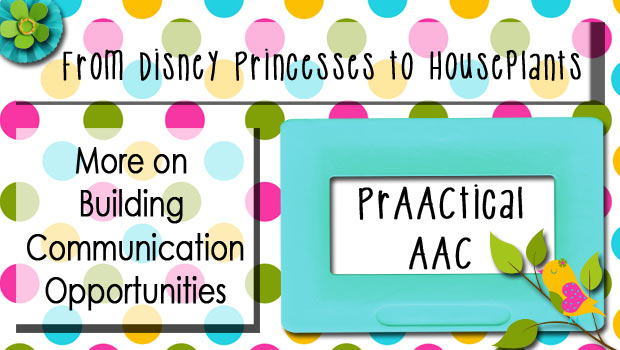
Mining everyday routines at home, in school, and in therapy sessions for communication teaching opportunities is a great way to get started in boosting the effectiveness of AAC intervention. We are inspired when we see clinicians enhance their clients’ learning by making subtle, but important changes. – I was thrilled to hear one SLP talk about how she ‘found’ more AAC practice for a teenager by offering more choices in her therapy games. Once he chose a TV character for the activity, LeVon then had to specify what action he/she would do (e.g., dance, drive, clap) and a location in which to do it (e.g., home, school, beach). Agent, action, location. Hmm…sounds like a good start for sentence-building, with a little aided language input and expansion thrown in for good measure. “Quinn drive beach.” “Yes. Quinn drove to the beach in his truck.” And it gives us great pleasure to... [Read More...]
April 23, 2012
by Robin Parker -
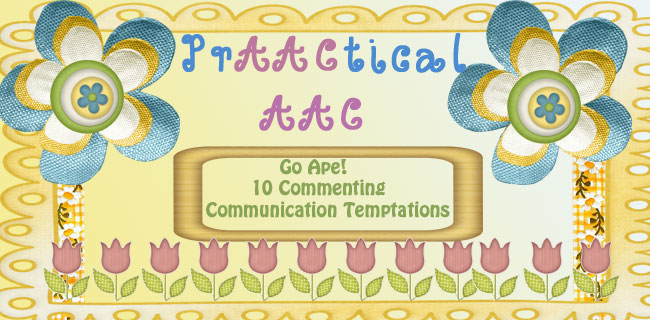
More About Communication Opportunities: It doesn’t matter your personality, but for students who do not naturally comment, you need to go ape! And then still, you need to teach with wait & signal cues, visual supports, aided language input, modeling, expansions, and positive feedback. We will never forget a semester with Mikey and our hair clips of butterflies, whales, dinosaurs, and even a spider. These hair clips allowed for the item to hang in our face…… until Mikey commented and we could ‘go ape’ with surprise. A great strategy to use with commenting communication temptations is Wait & Signal. Wait and Signal involves setting up the temptation and then pausing with raised eyebrows like you expect the learner to take a ‘turn/a conversational turn’. As always, make sure the learner has access to the appropriate communication device or communication boards. 10 additional commenting communication temptations and opportunities: Move a huge stuffed... [Read More...]
April 21, 2012
by Carole Zangari -
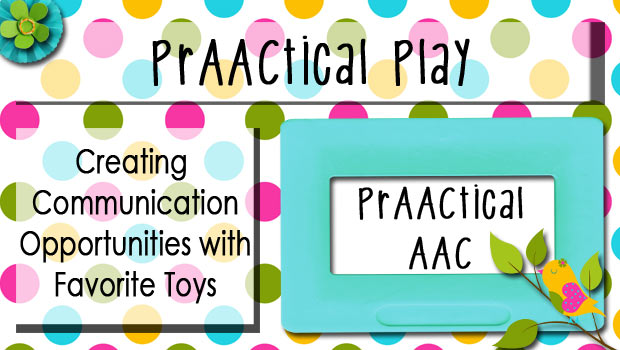
– Guest post by Stefanie Finocchio, M.S., CCC-CF As we’ve said before, we feel incredibly fortunate to have made our careers educating the next generation of SLPs. Sharing what we’e learned about AAC, AT, autism, literacy, and language intervention with graduate student clinicians is a challenge we both love. In this post, we share the wonderful ideas of a recent graduate, Stefanie Finocchio. Although she has only been out of grad school for a few months, Stefanie has some very prAACtical ideas about how to create communication opportunities for young children who are learning to use AAC. – One of my favorite “go-to” activities/games that I use frequently with my students diagnosed with autism is the Playskool Busy Gears game by Hasbro. It comes with 11 plastic gears of all different sizes and colors. Once a gear is placed on the board, you hit a button on the bottom and... [Read More...]
April 18, 2012
by Carole Zangari -
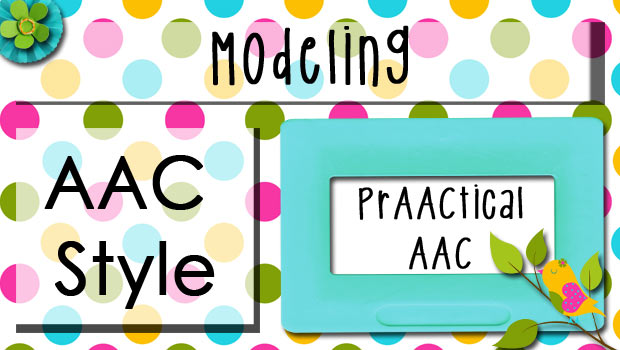
This is a strategy that is too powerful to ignore. Here’s why Aided Language Input is at the top of our list of skills that all clinicians should master. – 1. Helps children and adults learn their AAC faster: There is good research demonstrating how valuable this kind of modeling is for our AAC clients. See studies by Drs. Kathryn Drager, Cathy Binger and Janice Light, Jennifer Kent-Walsh, Shakila Dada and Erna Alant for starters.– 2. Helps the SLP get competent with the client’s AAC system: This is hands-down the quickest way for us to get familiar with our client’s AAC device. – 3. It’s common sense: Think about it: How many times does a typical 1-year old hear the word ‘more’ before she says it?? Don’t AAC kids need that much exposure to ‘their’ language systems?? – 4. Expands our sphere of influence: Other communication partners will imitate us. If WE use it, then parents and teachers are... [Read More...]
April 7, 2012
by Carole Zangari -

April is springtime where we live and spring is a time of beginnings. It’s fitting, then, that our AAC strategy of the month speaks to the very beginning of AAC intervention. Learning how to create focused opportunities to teach or practice an AAC skill is a pivotal skill for SLPs. The concept is a simple one: create an environment in which the learner WANTS or NEEDS to display the target skill. – Communication opportunities are related to the concept of communicative temptations. As SLP blogger Becca Jarzynski of Child Talk puts it “Communication temptations are pretty much just what they sound like: we set up the environment to tempt children to communicate with us.” Stop by and read her excellent post here . While Becca focuses on their use with young children, the approach can be used with people of any age. – Tempting people to communicate is all about... [Read More...]









